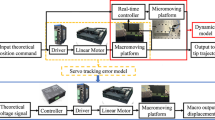Abstract
At present, ultra-precision cutting technology has been studied in Korean research institutes, focusing on development of ultra-precision cutting tool technology and ultra-precision control engineering. However, the developed technologies are still far behind advanced countries. It focuses on metals including aluminum, copper and nickel, and nonmetals including plastics, silicone and germanium which require high precision while using a lathe. It is hard to implement high precision by grinding the aforementioned materials. To address the issue, the ultra-precision cutting technology has been developing by using ultra-precision machine tools very accurate and strong, and diamond tools highly abrasion-resistant. To address this issue, this study aims to conduct ultra-precision cutting by using ECTS (Error Compensation Tool Servo) to improve motion precision of elements and components, and compensate for motion errors in real time. An IR camera is used for analyzing cutting accuracy differences depending on the heat generated in diamond tools in cutting to examine the heat generated in cutting to study cutting accuracy depending on generated heat.
Similar content being viewed by others
Abbreviations
- Fm:
-
main cutting force
- Fr:
-
radial/thrust cutting force
- Fa:
-
feed cutting force
- N:
-
shape function
- â :
-
parameter
- B :
-
deformation rate matrix
- E :
-
Young’s modulus
- v :
-
Poisson ratio
- σ ij :
-
stress
- ε ij :
-
deformation rate
- f e :
-
applied force
- K e :
-
element rigidity matrix
- a e :
-
knot parameter
References
Roland, G., “Design and Fabrication of a Three Mirror Flat Field Anastigmat for High Resolution Earth Observation,” Proc. of SPIE, Vol. 2210, pp. 739–746, 1994.
Kim, J., Lee, H.-N., Kwac, L., Han, J., Cho, Y.-T., and Jun, C.-G., “Control Performance Evaluation of Ultra Precision Positioning Apparatus,” Proc. of the 2000 International Symposium on Mechatronics and Intelligent Mechanical System for 21 Century, pp. 252–255, 2000.
Shiraishi, M. and Uehara, K., “In-Process Control of Workpiece Dimension in Turning,” Annals of CIRP, Vol. 28, No. 1, pp. 333–337, 1979.
Becker, P., Dorenwendt, K., Ebeling, G., Lauer, R., Lucas, W., et al., “Absolute Measurement of the (220) Lattice Plane Spacing in a Silicon Crystal,” Physical Review Letters, Vol. 46, No. 23, pp. 1540–1543, 1981.
Kim, H.-S. and Kim, E.-J., “Feed-Forward Control of Fast Tool Servo for Real-Time Correction of Spindle Error in Diamond Turning of Flat Surfaces,” International Journal of Machine Tools and Manufacture, Vol. 43, No. 12, pp. 1177–1183, 2003.
Falter, P. J., “Diamond Turning of Nonrotationally Symmetric Surfaces,” Ph.D. Thesis, North Carolina State University, 1990.
Donaldson, R. R. and Patterson, S. R., “Design and Construction of a Large, Vertical Axis Diamond Turning Machine,” Proc. of SPIE, Vol. 433, pp. 62–68, 1983.
Ljubarsky, S. V., Sobolev, V., and Shevtsov, S. E., “Optical Surface Fabrication on Ultraprecision Machines,” Proc. of SPIE, Vol. 1266, pp. 226–236, 1990.
Nakazawa, H., “Principles of Precision Engineering,” Oxford University Press, USA, 1994.
Becker, E. B., Carey, G. F., and Oden, J. T., “Finite Elements, an Introduction: Volume I,” Prentice-Hall, 1981.
MARC Manuals, “MARC Analysis Research Corporation,” 1994.
Kim, J. Y., Han, J. H., Kim, H. W., You, S., Kwac, L. K., and Song, I. S., “A Study on the Optimal Structural Design and Ultra Precision Position Control using FEM for Micro Stage,” Proc. of KSPE Conference, pp. 336–340, 2001.
Park, D.-K., Lee, G.-I., Gao, J.-C., and Kim, J.-Y., “Research on The Design of the Ultra-High-Precision Positioning Control Error Compensation,” Int. J. Precis. Eng. Manuf., Vol. 17, No. 10, pp. 1351–1358, 2016.
Author information
Authors and Affiliations
Corresponding author
Rights and permissions
About this article
Cite this article
Lee, GI., Gao, JC., Jung, YS. et al. Study of Heat Generation and Cutting Accuracy Depending on Spindle Rotation Speed Change in Ultra-Precision Cutting Using ECTS. Int. J. Precis. Eng. Manuf. 19, 265–269 (2018). https://doi.org/10.1007/s12541-018-0031-1
Received:
Revised:
Accepted:
Published:
Issue Date:
DOI: https://doi.org/10.1007/s12541-018-0031-1




